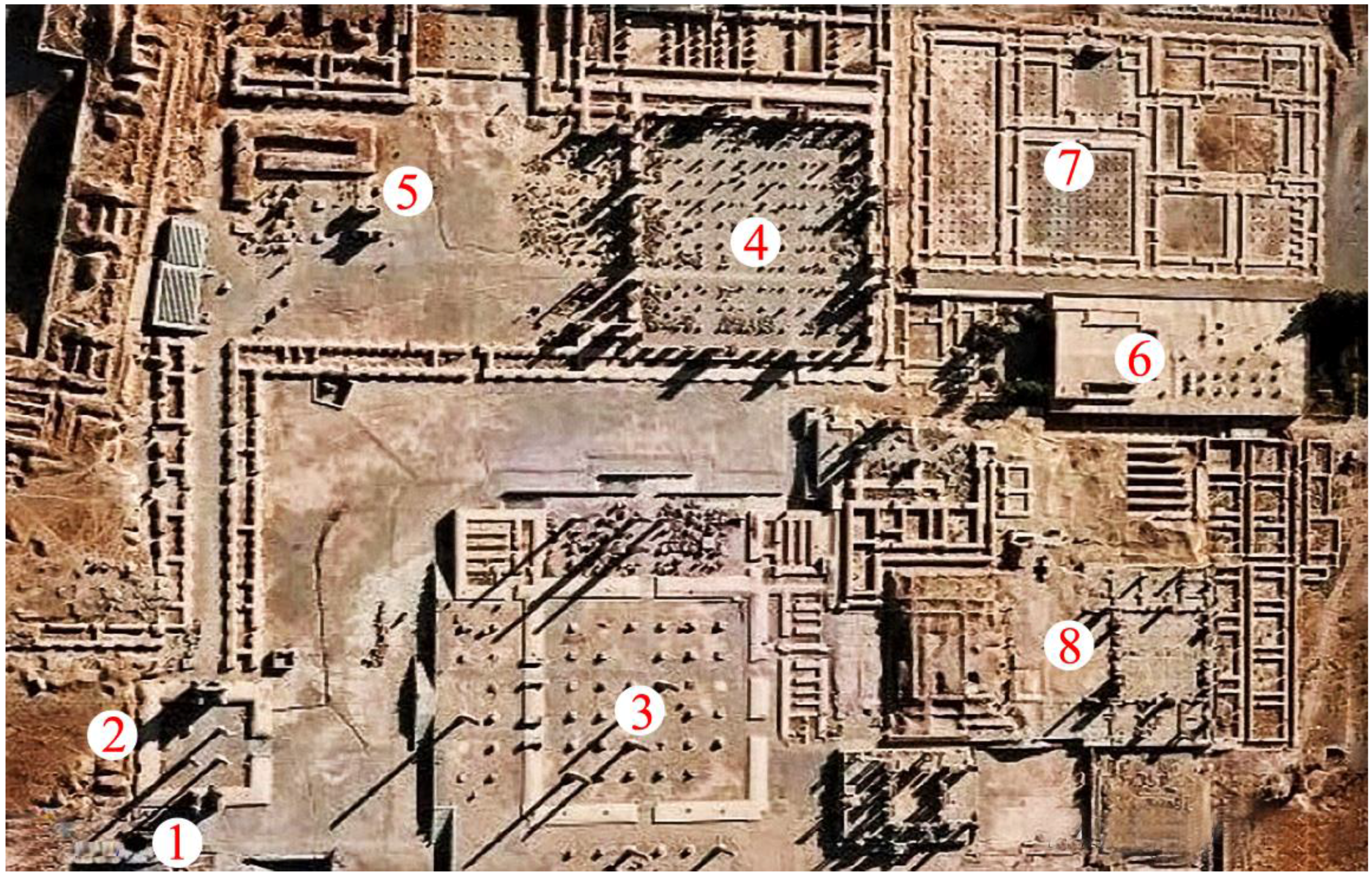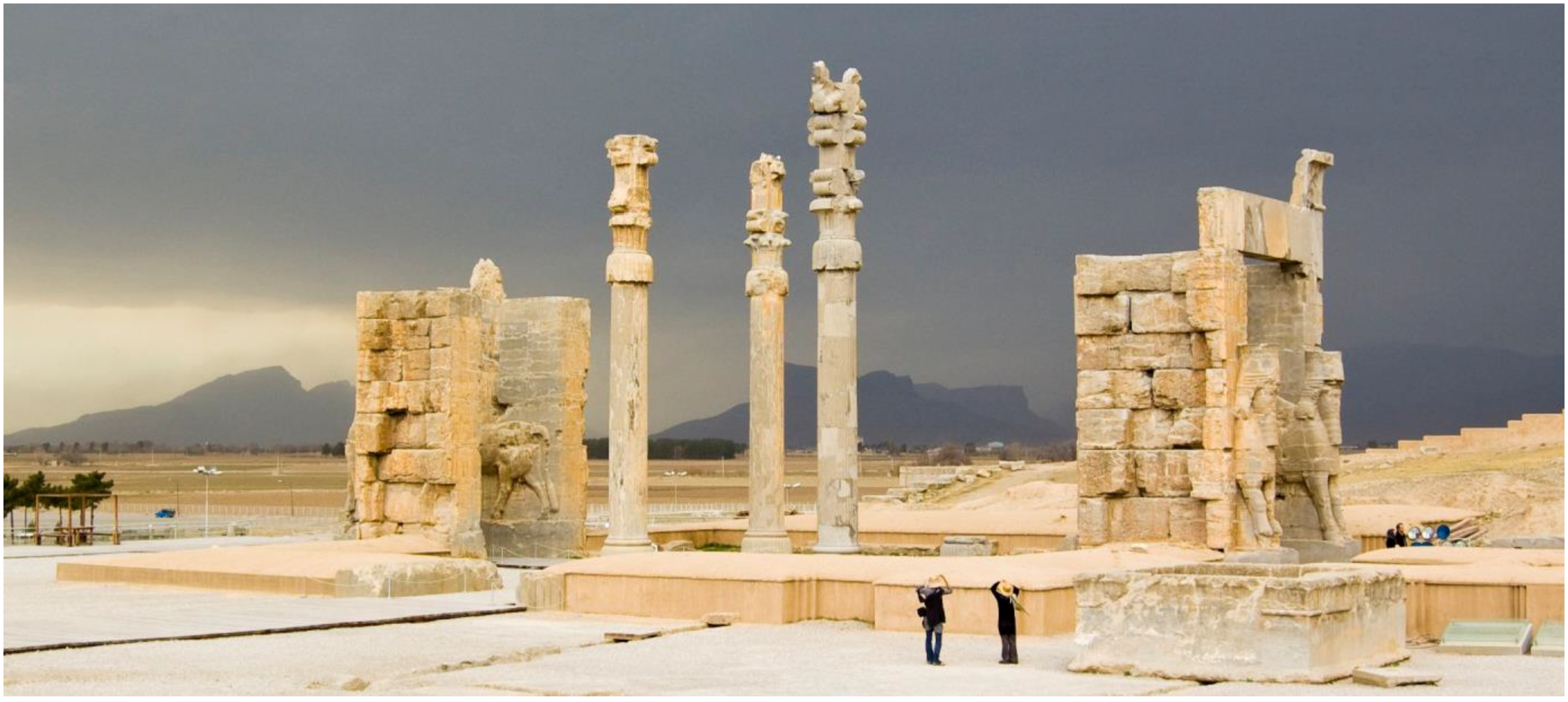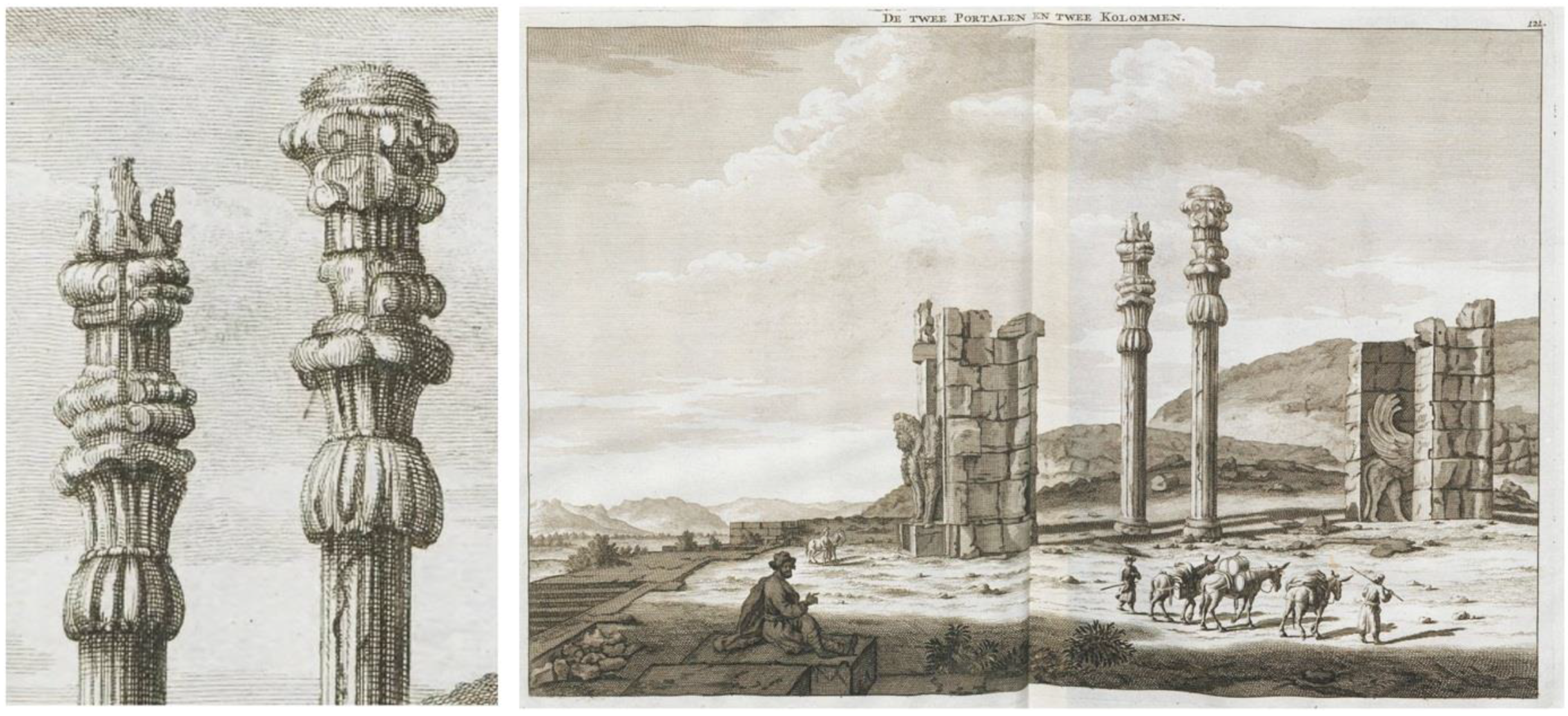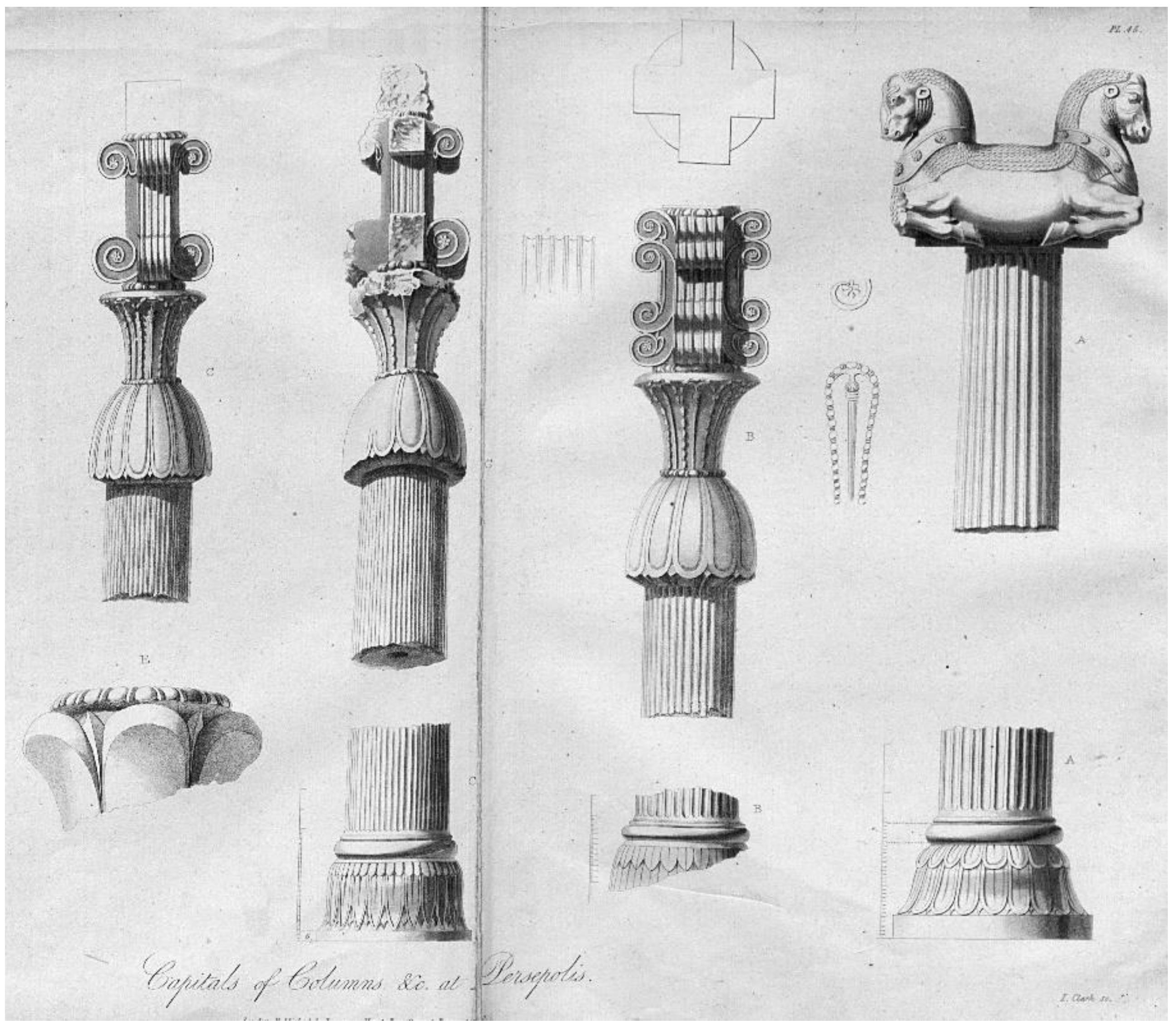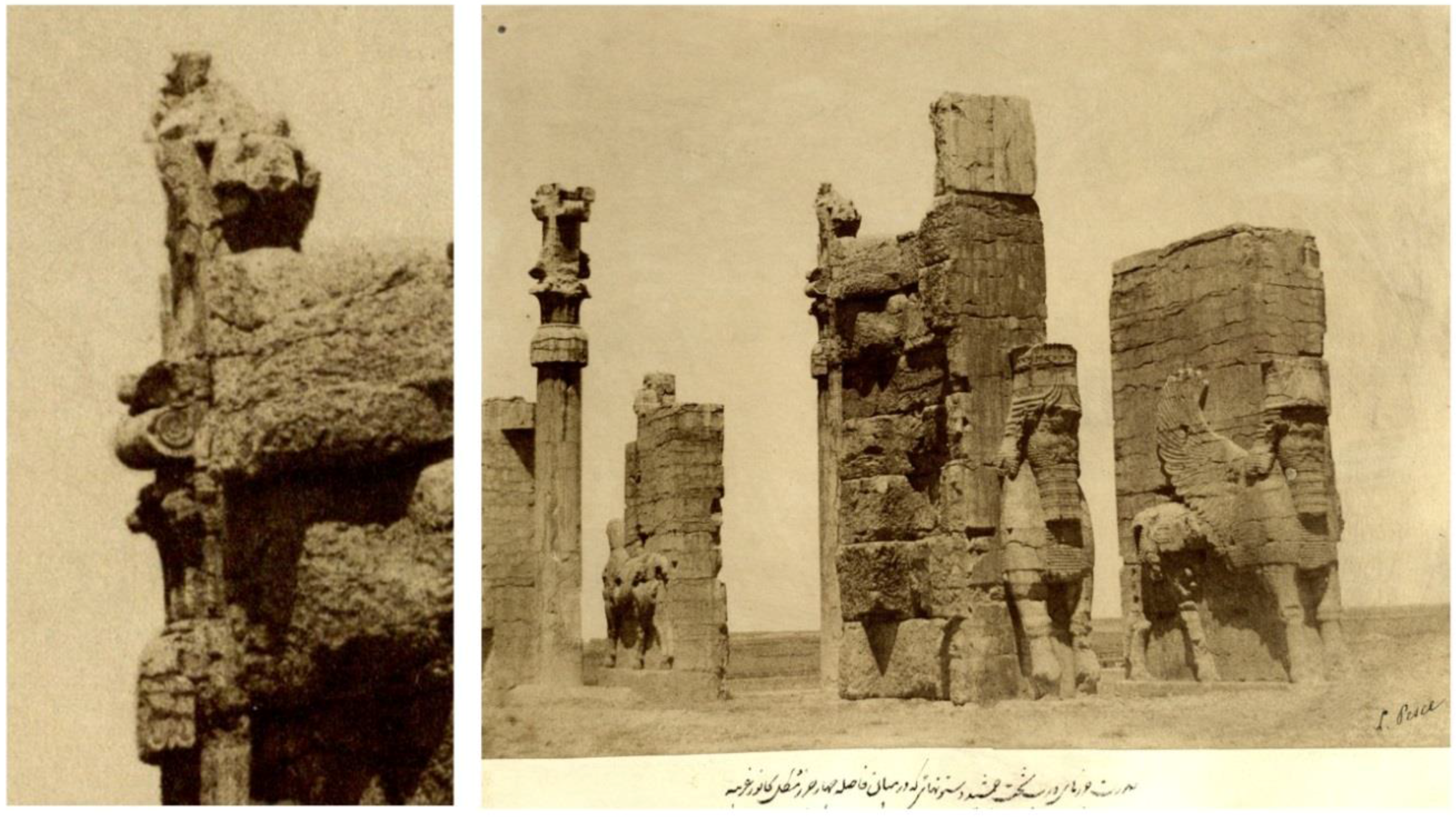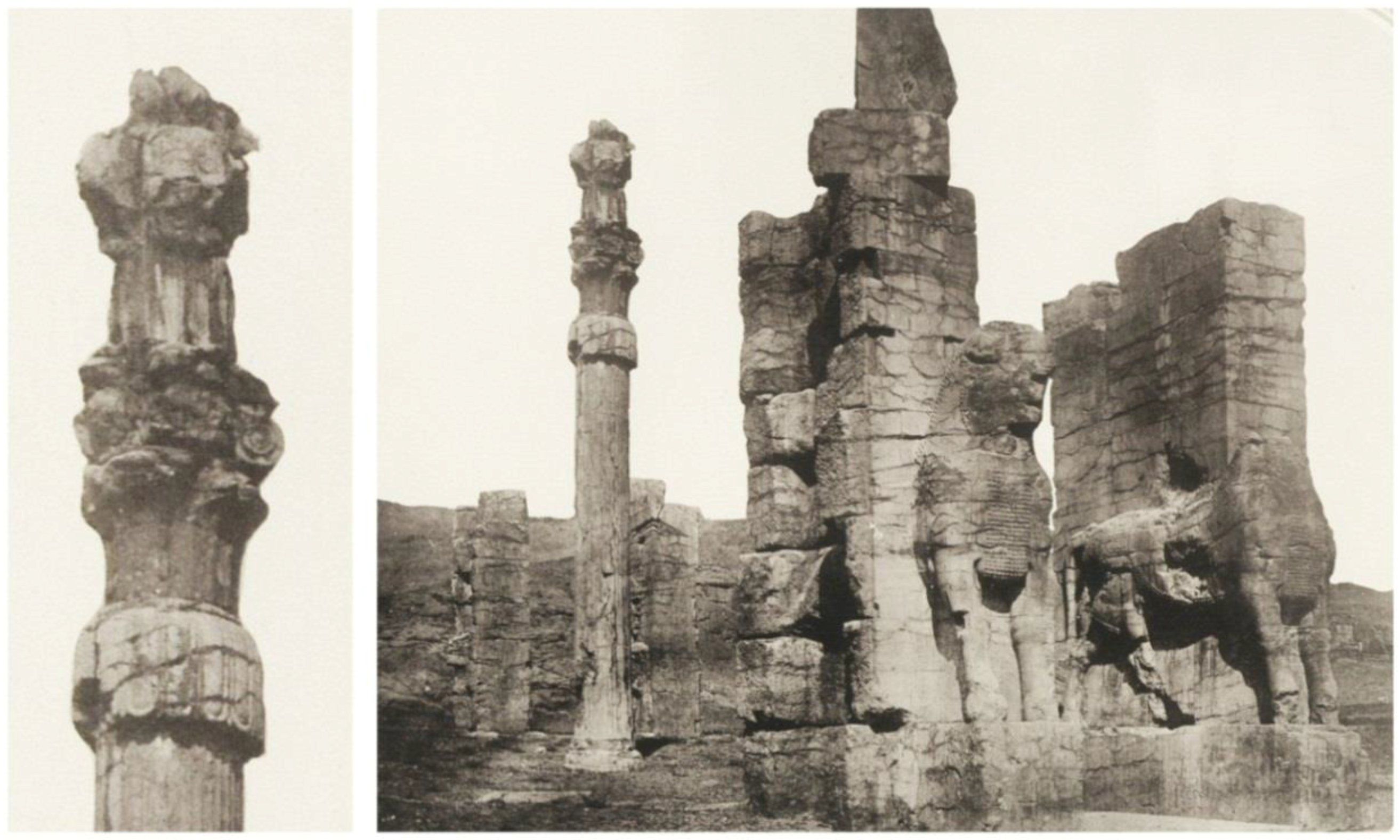3.1. Travelers’ Accounts and Historical Pictorial Evidences
Three travelers, De Bruijn, Chardin, and Kaempfer, who visited Persepolis from the late 17th century should be considered among the first visitors “who made an effort at true exploration: the recording of the available evidence” [
20] (p. 15). They can provide us with the most accurate information about the condition of monuments at the time of their visit.
The French businessman and traveler, Jean Chardin, visited the site three times between 1665 and 1677. He has presented one of the best conspicuous descriptions of these ancient monuments [
14] (p. 101). Explaining, precisely, the totality of the Gate of All Nations (pilasters, dimensions,
etc.) he postponed discussion about the columns to later paragraphs. However, when he, again, commenced this topic he did not refer to the Gate anymore and mainly focused on the columns of the Āpādānā [
21] (pp. 102–108). Here he noticed the existence of a complete animal protome above the columns and his less precise drawings (Plate. N.LX) show this issue correctly [
22]. Comparing the column depicted in this drawing next to some broken pieces of capital elements with the condition of the Gate during the first round of excavations, it can be assumed that the depicted column can be the one which is under our survey ([
23], Figure 25). In that case, his drawing shows the existence of considerable pieces of unshaped stone on its upper part that belong to the protome.
Benefitted from the prolific condition of the Netherlands during the seventeenth century Cornelis De Bruijn, a well-trained Dutch artist, made several travels to the East. He was an experienced painter that had valuable trainings under the supervision of some of the most well-known painters of his time [
24].
His book, Travels into Moscovy, Persia, and the East Indies, was actually Bruijn’s second travel account that demonstrates his adventures between 1701 and 1708. As can be seen in the full title of the book, the emphasis is on Persepolis. Bruijn arrived at Persepolis in 1704 and, for about three months, he accommodated in a village next to the ruins. This made him able to make the most accurate paintings from these ancient vestiges.
Indeed, the accuracy of his drawings is based on the fact that they were not prepared as rough sketches but rather they were detailed figures that were drawn
in loco and were even completed with watercolor [
25]. In several cases he mentioned this aim and explained that his desire is to “examine [the] ruins with the greatest care and to render to them more known to the curious than they had been till then” [
26] (p. 23). Unlike the conventions of his era, he did not blend his own perceptions about a possible shape of architectural elements and ornaments with his prepared drawings [
14] (p. 106). Comparing his illustrations with photographs taken from the terrace before the start of excavations, we can find considerable similarities [
27].
In most of the travelers’ accounts that were published before the arrival of new technology of photography, the process of making appropriate pictures had been always a big problem. In most cases artists who were accompanying travelers were not appropriately experienced and, even in some cases, they were not motivated enough to invest their highest levels of art in their paintings [
28] (pp. 257–258). Moreover, after the preparation of the first-hand paintings and before publication, travelers had to challenge the second phase, which was the making of engravings from original pictures. Unskilled engravers could easily destroy all previous efforts by the artists. Being aware of these matters, Bruijn emphasized that not only he painted the original pictures based on his keen observations, but also he paid a considerable attention in the second phase of work, since all completed details by the engravers, had to satisfy his precise inspecting eyes [
26] (p. 211).
One of the outstanding historical illustrations from the Gate of All Nations is depicted in Plate no. 121. In this picture, the most northern column is illustrated accompanied by all components that shape a column in an Achaemenid style. Direction of the addorsed bull can be easily distinguished by comparing the shape of a complete animal motif with this depicted vestige. Specifically, the hole that is hewn between the two joined bulls and traces of rosette ornaments on the chest of beast motif are notable (
Figure 5. Left). The addorsed bulls were not always carved from a single piece of stone and their knees were constructed from separated elements, joined to their body by the means of primitive joining techniques. In most cases the sculptures’ feet are damaged or cut from the motif’s body. This is the case in regard to our under discussion stone capital. De Bruijn’s illustration demonstrates the loss of the knees. The depicted condition of this capital is not only presented on this plate, but also on his other illustrations from the ruins (e.g., plates no. 120, 124).
Moreover, De Bruijn’s technical and precise descriptions of the ruins are considerable. In several cases, he asserted some points about the zoophorous vestiges. In his general review of the site he expressed the well-preserved condition of the columns of the Gate and, specifically, the capitals. He wrote: “The two columns that appear between the two portals, are the least damaged of all, especially with respect to their capitals and the other ornaments of their upper part” [
26] (p. 12). At the last part of his descriptions of the Gate, once more he returned to these columns and their capitals. He, referred to other travelers’ observations and asserted:
“Some writers pretend that there are winged horses of an uncommon magnitude on the two columns that are near the two portals, on the side of the stair-case, in the façade of the edifice; and one author in particular affirms, that he had seen them, tho' Without mentioning in what year; but he takes no notice, at the same time, of the camels that are placed on the others: This however is a fact which I can take upon me to aver, and that they are still to be seen on their knees, on one of the nine columns, without capitals, and which are placed in a lateral position to each other. This camel is, indeed, greatly damaged, but, however, one part of the, body is still visible, with the two fore feet, and several ornaments that resemble those of the animals in the first portals. One cannot be deceived in this particular, if one examines the pieces which are fallen from the tops of these columns” [
26] (p. 25).
He did not name travelers who made these observations, but the text demonstrates that he accepted the well-preserved condition of the zoophorous capital in a way that he could even recognize the similarity of its ornaments with the surviving capital of the western portico of the Āpādānā.
German orientalist and scientist Engelbert Kaempfer was the secretary of a Swedish legation who was destined for the Russian and Persian courts. He had a constant interest in historical sites and his descriptions illustrate his meticulous observations. Kaempfer arrived at Persepolis in 1686 and stayed at the site for three days examining the vestiges of almost all ancient buildings. Ultimately, he made five drawings from the ruins [
29]. In a painting that he presented from the site the Gate can be distinguished. Unfortunately, the work of inexperienced engraver caused the published pictures to turn out insignificant [
30]. Additionally, he has some remarks about the Gate of all Nations as “Structure I” in his book,
Amoenitatum exoticarum. He called the building as “Propylaeum” and roughly examined the monstrous motifs, which were hewn on entrance pilasters. Moreover, he mentioned the existence of a roughly shaped motif on one of the columns, which were, in his eyes, similar to those motifs, which are carved on the pilasters [
31] (pp. 336–338).
Stephen Flower, the agent of the East India Company in Persia, visited Persepolis in 1661 [
20] (p. 23). He was an accurate, smart viewer who paid a great attention to detail. This can be traced in his letters to the Royal Society, who was supposed to support him with the costs of preparation of drawings from Persepolis. A skilled painter accompanied Flower on his journey to Fārs and it seems that he and Flower had agreed on details of their collaboration [
14] (pp. 114–116). Flower is mostly renowned for his sketches of cuneiform inscriptions, however, his interest in regard to the pictures from Persepolis brought these drawings among the best-prepared paintings which accurately demonstrates the condition of the monuments in the late seventeenth century. There is a probability that
Persepolis Illustrata, a rather anonymous book published in 1739, is inspired by Flower’s drawings of the ruin. Ali Mousavi, the renowned archaeologist, suggests: “Comparing to earlier and latter illustrations, this book is quite reliable” [
32]. Back to the topic of discussion, a highly detailed drawing of this book (Plate. X) presents the Gate of All Nations. The northern column of the Gate is depicted with the remnants of its uppermost motif, and like Bruijn’s illustration, this capital has the east-west orientation (
Figure 6).
Sir Ker Porter, the English traveler, visited the ruins of Marvdasht in 1818 and stayed near the site for about ten days. His accounts demonstrate his endeavor to present an accurate vision of the site, monuments, and their history [
14] (pp. 127–130). His keen, experienced eye, which is necessary for a skillful painter, supported his effort. He meticulously measured the structures and presented some of the best-drawn pictures of these ancient monuments from before the modern time. Noted in his preface to the account, the main aim of these drawings was to demonstrate the state of monuments at the time of his visit [
33] (p. viii). He precisely described the Gate of All Nations and its consisting elements. He was careless in reading Chardin’s account, as he wrongly noted that the French traveler had seen all the four columns erect [
34]. Regarding the capitals he asserted:
“Their capitals are singular and beautiful; consisting, as it were, of three combined into one… The surface at the top of the capitals is perfectly smooth, without the least vestige of any loos fragments; and I should led to imagine, that when the four stood erect, and were united, they might have sustained the plane or pedestal of some sculptured symbolical image.” [
33] (pp. 590–599).
Subsequently, in his drawing (
Figure 7) the columns were depicted without the beast protomes. One question still remains: why did such a precise observer not mention a vestige of stone zoophorous which, at the time of his visit, was definitely extant? We may find the answer in his more precise descriptions of the Āpādānā, specifically in the columns of its central hall. There, Porter noted the similarity of the columns’ capitals with those of the Gate. Interestingly, he did not distinguish traces of beast motifs standing above some of the pillars and just named hallowed lotus and volutes as the tripled compartments of a capital [
33] (p. 637). In order to justify his observations from the uppermost part of stone materials visible above volutes, he asserted that they are traces of piers for a throne-like roof that once surmounted the columns of the central part of the hall [
33] (p. 638). The impossibility of settling the piers of a throne-shaped roof above the beast capitals made him to overlook these visible vestiges.
Eugène Flandin, the French orientalist, artist, archeologist, and politician visited the site in 1841. For many years before his travel to Persia he was known as a skillful artist and his paintings were even bought by the King of France [
35] (p. 58). However, Flandin gained more fame by his renowned paintings of Persian landscape, architectural monuments, and people, produced during his stay in Persia between 1839-41. As a laureate of the Institut de France, Flandin accompanied the French embassy to Persia. The mission’s aim was to obtain as much information as possible about the country’s progress under the Qājār dynasty and make a complete inventory of the ancient and modern monuments of the country [
35] (p. 58). Nevertheless, the mission did not stay in Persia for a long time and they left Flandin and his French colleague, Pascal Coste.
Coste was older and more experienced than Flandin. He had a good resume of previous, successful missions to Egypt and published paintings [
35] (p. 258). He was trained as an architect and had excessive travels around Europe, Russia, North Africa, and the Middle East. His writings, drawings, and archeological explorations were notable as well. Interestingly, almost about a decade prior to his mission to Persia, he was an appointed professor at the École d’architecture de Marseille [
36].
What distinguishes the French scholars’ accounts from other travelers’ memoirs is their aim (as discussed earlier) to provide the French government with the most reliable and accurate information about Persia. In relation to our topic, what assure us about the authenticity of architectural details in their illustrations and inscriptions are their academic background and their previous experiences which caused them to be considered among the best experts living in France at that time [
14] (p. 135).
They spent almost about two months among the ruins [
37] (p. 174). Returning to France, they published the result of their extensive travels in Persia in a series of books entitled Voyage en Perse in 1851. While the architect, Coste, was responsible for architectural rendering and plans of the monuments, Flandin, the painter, took the task of representing architectural details and picturesque views, as well as writing the context of the voyage [
14] (p. 134). In the process of publishing their original drawings, they both collaborated with engravers [
36]. This point assures us about the accuracy of archeological details in their published drawings and “Coste’s maps and drawings of structures were among the first accurate visual documents of Persepolis” [
14] (p. 135). Their “true-to-nature” illustrations provide us with the precise state of the Gate and its surrounding monuments in 1841.
Their extensive panoramas from the site are not the only sources representing the Gate; rather, fourteen other illustrations (Plates 73–86) specifically focus on this structure and its architectural ornaments [
38]. Moreover, they presented a reconstruction design for the Gate [
38] (Plate. 87). In their drawings from the under study column, their illustrations exhibit the condition of a damaged capital and its uppermost part. The western and eastern profiles of the Gate (Plate. 73), which properly demonstrate the upper parts of the columns, illustrate an appropriate harmony between the remains of these capitals and the frontal view of the beast capital that is depicted in Plate. 76.
In their travel account, Flandin precisely examined the order of monuments on the terrace and their condition [
37,
39]. Despite the lack of access to our modern surveying instruments, the French scholars presented some of the most accurate surveys from the site that was only superseded by E. Schmidt almost one century later [
15] (p. 55). Interestingly, both Schmidt and Krefter alternatively referred to the French orientalists’ measurements and drawings in their publications.
In a book which accompanied their collection of illustrations, Voyage en Perse, which actually served as a guide for a better understanding of depicted figures, Flandin examined the Gate precisely and provided his reader with meticulous observations of the standing columns [
39] (pp. 81–83). Introducing the reader to different parts of these columns and especially the triple-part capital, then he continued his descriptions to the zoophorous capital. He described the form of an addorsed bull, the way two motifs are connected to each other and how the void space on the saddle of the motifs were used for the settlement of wooden architraves. Ultimately, he proceeded to the arrangement of the zoophorous capital and said [
40]: “From this point, one can easily realize the impact which was produced by these bulls. The front view of the portico offered profiles of these animals while in the spaces between columns viewer could see their foreheads and chests” [
39] (p. 83).
The French scholars believed in a mediatory function for the Gate of all Nations, something like a half-open space that prepared visitors for entering into the Audience Hall, Āpādānā. In this way, the building was conceived as a portico, that its open face was towards the northern porch of the Āpādānā. Considering this point, when Flandin remarked the front face of the portico, we know that he was referring to the southern side of the Gate. This fact can be witnessed in their reconstruction design, which is presented in Plate. 87. This part of this valuable account clearly demonstrates the west–east orientation of the capitals (
Figure 8).
In another publication which followed by the first series in 1852, Flandin again returned to the Gate [
37] (p. 156) and his explanations proves the partially-preserved condition of the protome at the time of his visit. Moreover, the orientalists’ attention towards this portion of the capitals can be proved by comparing the dimensions they presented for the total length of a column (16.58 m) with those measurements that were suggested by Schmidt (16.66 m) [
23] (p. 68).
Soon after Flandin’s expeditions, the new art of photography superseded his pioneering work in archeological drawing [
36]. The invention of photography backs to early decades of the nineteenth century and soon found its way to Persia. In comparison to traditional media, like painting, photography can provide us with more details and the essence of objects can be presented beyond the perceptions of observers. Nevertheless, as a result of unskilled photographers and the preliminary available technology, most of the early captures scenes are not particularly significant.
The first pictures made from Persepolis back to the late 1850s by the Italian officer, Luigi Pesce [
14] (pp. 138–139). The original pictures are now kept in Golestān Palace Museum in Tehran. One of Pesce’s photographs has captured the state of the Gate properly [
41] (Photograph no. 35). Though this picture is taken towards the northwestern part of the site and it depicts the whole Gate, similar to those drawings made by the French orientalists, still, the existence of parts of the motif’s chest can be distinguished (
Figure 9, left part).
The author’s interpretation of this picture can be proved by an illustration of the Gate that was drawn by Alberto Passini almost at the same time. Passini was a well-trained artist and “his quasi-photographic representation of architecture and figures are a world apart from the imaginary exoticism of earlier orientalists” [
35] (p. 124). In a sketch he drew
in loco from the Gate (towards south) in 1855 and a more completed gouache painting that he presented from this preliminary sketch in 1858, evidences of the chest of protome are presented ([
42], Figures 47 and 226).
In later years many visitors, who were equipped with cameras, captured the state of Persepolitan monuments and the Gate of All Nations. German scholars, Franz Stolze and Friedrich Carl Andreas, in their expedition visited Persepolis in 1882 and took a considerable number of pictures from the site. Their pictures are accounted as the first scientific photographs from the terrace [
14] (p. 145), albeit “the usual shadow, over-exposure, spots and cracks in the glass plates” are an inseparable part of these illustrations that were soon published [
43]. Stolze took several pictures from the Gate. In one of these photos, “Propylaea of Xerxes”, he illustrated the column under survey [
44]. Considering the depletions mentioned above, this picture cannot provide us with an appropriate suggestion about the orientation of the bull, but it demonstrates a considerable deterioration of its upper part (
Figure 10).
To the precious early photographic records from Persepolis we should add the superior pictures of Marcel Dieulafoy, a French architect who, with the company of his wife, visited Iran and Persepolis before the start of their excavation at Susa in 1885 [
45]. Although he made some photographs from the Gate and its monuments, there is no trace of the discussed capital. In a half-cut picture from the Gate, which is published in their memoir, the other column of the Gate is illustrated [
46] (Pl. XXI). Definitely in the original photograph the second column was visible, but since there are not any traces of original pictures, we cannot benefit from this valuable source in this survey [
47].
Other early photographic materials, more or less, have inappropriate quality. Since photographers tried to capture the totality of the site and its monuments, these photographs are valuable for general studies and not for the sake of architectural details. There is no considerable difference between the amateur photographs of the Dutch tradesman, Albert Hotz, in 1890 or the professional examples made by Armenian photographer, Antoin Sevruguin, in the late nineteenth and early twentieth centuries [
48,
49]. Even German scholars F. Sarre and E. Herzfeld do not provide us with better choices in their extended atlas of pictures of Persian monuments [
50] (Tafel. XV, XVI, XVI). They all made pictures of the Gate and the author of this paper has profoundly studied them. Indeed, the quality of these pictorial materials made the studying of an object that is more than twenty meters farther from the camera, difficult and unreliable.
Finally, we should name G. N. Curzon, who visited the site in late 1889. His exact observations, which were supported by his eloquent pen, are among the best descriptions of Persepolis before the dawn of scientific archeology on the terrace [
14] (pp. 146–149). He called the Gate “the Porch of Xerxes” and widely examined the condition of this part of the ruins [
51] (p. 155). The extreme damage that was occurred to the “Bicephalous capital” at the time of Curzon’s visit can be traced in his text. Regarding the difficulty in describing the form of the capital he asserted: “Stolze thinks that the topmost capitals of these pillars were shaped in the form of a horse; but I see no reason for supposing that they terminated in anything else than the familiar bull-headed capital of the composite Achaemenian column, like their counterparts in other contemporary fabrics” [
51] (p. 158).
Unfortunately, developments in the techniques of photography were contemporaneous with the destruction of the zoophorous capital. The pace of deterioration under natural phenomena increased and, ultimately, when Herzfeld, in the 1920s and before his excavation at the terrace, for the first time shot his camera towards the column for capturing the state of capitals, just small fragments of unshaped stone remained [
52]. This proves that later pictorial evidence is not helpful in justifying the state of the zoophorous capital.
